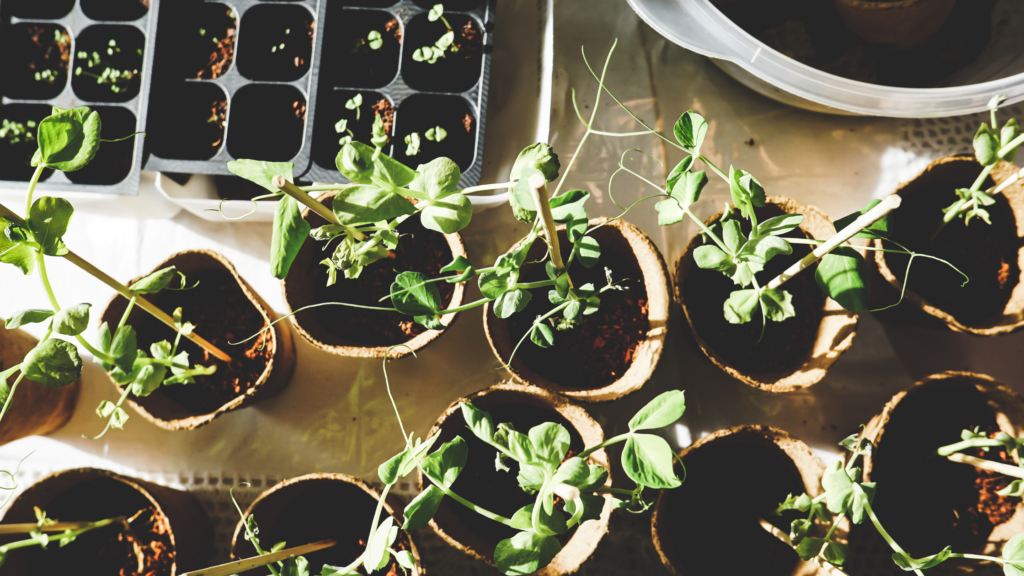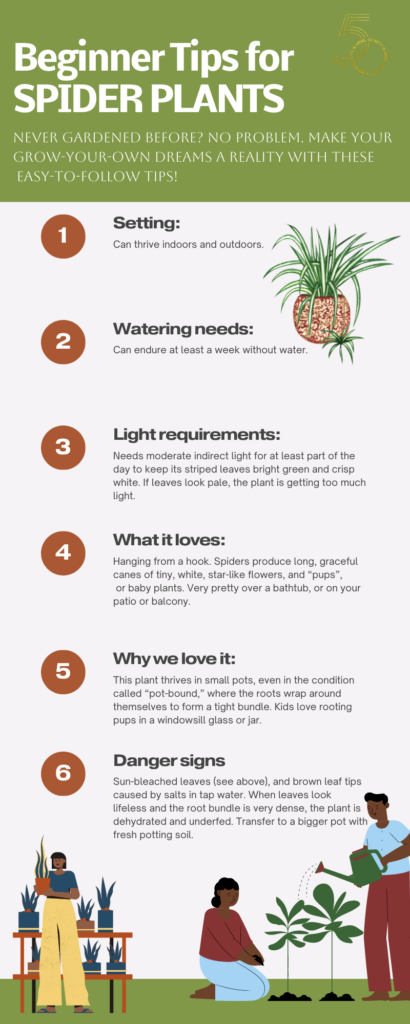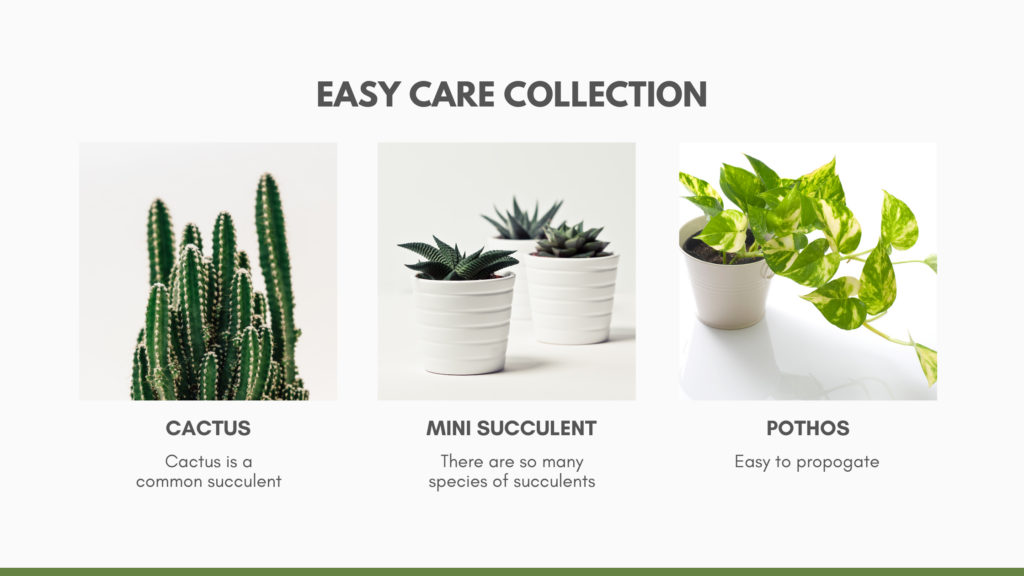
We celebrate Earth Day on April 22, and there’s no more joyful way to honor our planet than by appreciating plants. Think about it: even when you’re digging into that juicy filet mignon, it all started with plants in the form of grass and grain that feed our livestock. And not only do plants feed us: they feed themselves by pure magic. Scientists call it photosynthesis, the process by which plants make sugar (their food) out of…light.
If you think you don’t have a green thumb, really? Bringing plants into your space is easy once you figure out the equation of lighting, air flow, and relative humidity. And here’s the key to the health of any plant: the pot it’s in has to have holes in the bottom for drainage! It’s fine to put a plain pot with a drainage hole inside a larger, decorative pot with a solid bottom, as long as that runoff has someplace to go. Growing your own produce may be an option if you have an outdoor growing area. But even if you’re perfectly content to buy your cherry tomatoes at the market, consider these easy-care plants, starting with our favorite, the Spider!

Living plants in your home purify the air by reducing pollutants, a fact verified by NASA! Why does NASA care? Because simply packing some multivitamins will not be enough to keep astronauts healthy as they explore deep space. They will need fresh, raw leafy greens, just like you do. In addition to the nutritional benefits of eating fresh fruits and veggies, these essential foods fortify your body with water and fiber, so important as our digestive system matures and ages.
Right now, a “Veggie,” the Vegetable Production System, is a gravity-free garden residing on the International Space Station, where three types of lettuce, Chinese cabbage, mizuna mustard, red kale, and just for their beauty, zinnia flowers, are being successfully cultivated. Future crops will include berries, certain beans, and other antioxidant-rich foods for the added benefit of providing some space radiation protection for crew members who eat them.

A few more easy-care plants:
- POTHOS is equally forgiving, as symbolized by its heart-shaped leaves that readily form trailing vines. This plant is easy to share with friends, since cuttings root and grow quickly.
- SUCCULENTS thrive on strong sun and neglect! There are literally thousands of varieties, some of which produce extraordinary flowers in neon pink and acid yellow. Just be sure not to overwater these rugged desert natives.
- WHAT ABOUT CACTI? They’re fiercely beautiful and nearly impossible to kill. As with succulents, resist your urge to over-water. But here’s the thing: feng shui practitioners advise against cacti because the sharp thorns and itchy prickles attract negative energy and bad vibes, especially in the bedroom. Ouch!
- MILKWEED grown as an outdoor plant is one of the kindest things you can do for the environment, because it attracts butterflies, especially the threatened Monarch Butterfly. If a mama Monarch chooses your plant and deposits her egg there, you will soon have a voracious black-white-and-yellow striped caterpillar that will demand more, more, more milkweed!
Even if you’re a little creeped out by caterpillars, seeing the metamorphosis cycle which culminates in an impossibly beautiful jade green chrysalis with a metallic gold seal is a spiritual experience. If you’re really interested in Monarchs, you might consider getting a mesh covering (available on Amazon.com, under Butterfly Habitat) for your milkweed, to be used if and when you see a striped caterpillar on your plant. The reason: parasitic flies attack the beautiful chrysalis, killing the developing butterfly, and that’s sad. Get free milkweed seeds at www.livemonarch.com.

THREE MORE TO CELEBRATE EARTH DAY YEAR-ROUND:
- 1 – Your mother was right: eat your greens. By greens, we mean…green vegetables, especially leafy greens, steamed, stewed, baked, raw. Collards, dandelion leaves, spinach, field greens, lettuce, cabbage. And flowering greens: Brussel sprouts, broccoli, asparagus. Green peas, pea shoots, Chinese pea pods, and bean sprouts. Celery, even the leaves. Crunchy, crisp, filling, zero fat, almost zero calories, carbs. Green veggies are full of fiber and water as well as an array of vitamins. What about fruit? This may surprise you: not so much. In casual conversation, people talk about eating more “vegetables, fruit and whole grains.” While these vegan options may all have a place on your plate, they are very different from one another. Of course fresh fruit is delicious, but people with sugar sensitivities or a pre-diabetic or diabetic condition need to proceed with caution. What makes bananas, mangoes, peaches, plums, melons, cherries and grapes sweet is fructose, an epic sugar! Grains are now controversial among many nutritionists. The hybrid wheat that’s grown to make our bread and pasta is less nutritious and much higher in carbs than the original ancestral varieties. (Where do you think all that fluffy white bread comes from?) The same is true of modern rice. Of course, be sure to discuss all food choices and concerns with your doctor.
- 2 – Leam these two Japanese words: shinrin-yoku. In English, these words mean “forest bathing,” and no, you do not need to get naked or bring a towel. What it’s all about: immersing yourself in nature, surrounded by trees and foliage. Leafy plants exhale oxygen during the daytime, produced as the result of their photosynthesis process. So we feel refreshed and energized just standing or walking in their ancient presence. In fact, a growing majority of doctors and medical experts now agree that simply seeing trees and flowers through a hospital window helps their patients feel better and heal faster.
- 3 – Start Composting. What this means is using fruit and vegetable scraps and some other forms of kitchen waste to create a natural soil amendment. Microorganisms munch on the waste, and believe it or not, the resulting decomposition is a beautiful thing. Why is composting good for the earth? Because most food-related waste goes into landfills, and about 8% of greenhouse gas emissions come from this waste. Sadly, organic waste, not just fossil fuel and plastics, is linked to climate change. Food waste in landfills creates methane, a major factor in global warming. As you learn about composting, you may ask, but isn’t a landfill just like a compost heap, only bigger? Unfortunately, it’s not. A landfill is a dump. Anything goes, other than electronics. It is, as our grandchildren say, “random.” By contrast, healthy compost is carefully planned and tended. You can go big outdoors or keep it small indoors. There’s an art to it, and it takes patience. Some techniques employ deliberate fermentation, like the Japanese process called Bokashi. Others employ worms (“vermicomposting”), replicating the symbiosis on the forest floor. Okay, you can skip the worms if you like. If you’ve got space, you can start building a big ol’ stack outdoors. You can use a wooden chest or an old trash bin. If you’re starting a small stack indoors, you can find cute (yes, actually cute) little ceramic composting containers online. Or you can keep it simple and just use an empty milk or juice carton.
Be the first to comment